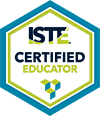

App Design for Beginners |
Explore and create : Creation lab
Nancye Blair Black Kevin Chaja
Got a problem? There’s probably an app for that. But if not, your students should design one! Learn to use MIT App Inventor, a free block-based programming environment, to teach fundamental coding and app design principles. In the process, create your own fun and engaging mobile apps!
| Audience: | Teachers, Coaches, Curriculum/district specialists |
| Skill level: | Beginner |
| Attendee devices: | Devices required |
| Attendee device specification: | Laptop: Mac, PC |
| Participant accounts, software and other materials: | MIT App Inventor Account: https://appinventor.mit.edu/; Android Emulator: http://appinventor.mit.edu/explore/ai2/setup-emulator.html |
| Topic: | Computer science & computational thinking |
| Grade level: | 6-12 |
| Subject area: | Career and technical education, Computer science |
| ISTE Standards: | For Students: Innovative Designer
|
| Additional detail: | ISTE author presentation |
| Influencer Disclosure: | This session includes a presenter that indicated a “material connection” to a brand that includes a personal, family or employment relationship, or a financial relationship. See individual speaker menu for disclosure information. |
App Design is a growing field, employing students who are innovative designers and computational thinkers alike. And as mobile devices become more and more pervasive, the number of these jobs will only continue to grow. In this session, participants will have the opportunity to learn about this critical topic from a powerhouse app design duo: a well-known app developer and the lead author of Edhesive’s App Design curricula. Participants will get a crash course in the fundamental app design principles students need to know and into the basics of App Inventor. With over 8 million users, the free MIT App Inventor is an accessible and popular app design program. Using a visual programming environment with block-based code, App Inventor grants both new and experienced coders the ability to design mobile apps. Participants will learn enough to create their first apps during the session, then extend learning to add features and interactivity. In the process, they’ll discover entry points and applications for engaging app design lessons in their own classroom.
1. Introduction to app design and MIT App Inventor, focusing on its importance to progressive computer science education and encouraging underrepresented students to consider computer science courses, majors, and careers (15 minutes). 2. App Design Walkthroughs , including a dual focus with coding/design elements and with app and game design concepts such as user interface, user experience, and game theory. Participants will make simple productivity and game-based apps (60 minutes). 3. Resources for further learning and classroom implementation (15 minutes).
Computational Thinking by Jeannette M. Wing; https://www.cs.cmu.edu/~15110-s13/Wing06-ct.pdf; Teaching Computational Thinking Is the First Step to Bridging STEM Skills Gap by Meghan Bogardus Cortez - https://edtechmagazine.com/k12/article/2016/11/teaching-computational-thinking-first-step-bridging-stem-skills-gap; Computational Thinking for Teacher Education
By Aman Yadav, Chris Stephenson, Hai Hong - https://cacm.acm.org/magazines/2017/4/215031-computational-thinking-for-teacher-education/fulltext; How to Teach Computational Thinking by Stephen Wolfram - http://blog.stephenwolfram.com/2016/09/how-to-teach-computational-thinking/ Logue, C. (2014). Design School 2.0:
Want to get students excited about STEM? Start an app design course. Retrieved from: http://www.scholastic.com/browse/article.jsp?id=3758416. Tomaszewsi, J. (2012). Students Learn App Development. boyd, d. (2014). It's Complicated: The Social Lives of Networked Teens. New Haven: Yale University Press. Berger, J. (1972). Richards, E. & Terkanian, D. (2013, December). Occupational employment projections to 2022. Monthly Labor Review, U.S. Bureau of Labor Statistics. Retrieved from https://www.bls.gov/opub/mlr/2013/article/occupational-employment-projections-to-2022.htm Change the Equation. (2015, December 7). The hidden half [blog]. Retrieved from http://changetheequation.org/blog/hidden-half Change the Equation. (2016, August 9). New data: Bridging the computer science access gap [blog]. Retrieved from http://changetheequation.org/blog/new-data-bridging-computer-science-access-gap-0 Cheryan, S., Plaut, V. C., Handron, C., and Hudson, L. (2013b). The stereotypical computer scientist: gendered media representations as a barrier to inclusion for women. Sex Roles 69, 58–71. Cheryan, S., Master, A., & Maltzoff, A. (2015). Cultural stereotypes as gatekeepers: increasing girls’ interest in computer science and engineering by diversifying stereotypes. Frontiers in Psychology, 6(49), 1-8. Google. (2015). Images of computer science: Perceptions among students, parents, and educators in the U.S. Retrieved from https://services.google.com/fh/files/misc/images-of-computer-science-report.pdf. Livingstone, S. (2009). On the mediation of everything: ICA presidential address 2008. Journal of communication, 59(1), 1-18. National Center for Women and Informational Technology. (2014). NCWIT scorecard: A report on the status of women in informational technology. Retrieved from https://www.ncwit.org/resources/ncwit-scorecard-report-status-women-information-technology National Science Board. (2016). Science and Engineering Indicators 2016. Arlington, VA: National Science Foundation (NSB-2016-1). Steinke, J., Lapinski, M. K., Crocker, N., Zietsman-Thomas, A., Williams, Y., Evergreen, S. H., & Kuchibhotla, S. (2007). Assessing media influences on middle School–Aged children's perceptions of women in science using the draw-A-scientist test (DAST). Science Communication, 29(1), 35-64. Weisbuch, M., Pauker, K., & Ambady, N. (2009). The subtle transmission of race bias via televised nonverbal behavior. Science 326, 1711–1714.


Nancye Blair Black is an ISTE-certified educator, keynote speaker, and consultant who cultivates dignity-driven instructional practices that empower educators, leaders, and students to succeed. Nancye is the author of nationally-implemented computer science curricula and several books, including Tablets in K-12 Education and the Hands-On AI Projects for the Classroom series. She is ISTE's AI Explorations Project Lead, a ProjectSTEM Designer, and a TC Games Research Lab leader. She's completing her doctoral degree in Instructional Technology at TC Columbia University. Talk to her about equity, AI, ISTE Cert, unique educational experiences, anything you're passionate about! @NancyeBlackEdu.
